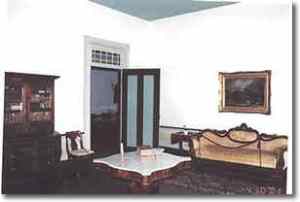Ladies Parlor
The Ladies Parlor, also known as the Bradley Room, has been furnished in memory of Mr. and Mrs. W. C. Bradley, parents of Mrs. D. Abbott Turner, by Mr. D. A. Turner.
The center room in the front of the Inn with a separate front door was used by first class travelers and as a ladies withdrawing room. Gentlemen also used this room. An interesting detail in this room is the shamrock design at the top of the woodwork on the window and door frames. The color of the paneling is quiet unusual. The paneling has the same “cut out” corner design that is repeated on the outside of the front door to this room and the Public Room.
Deeply worn treads of the staircase to the second story indicate a tremendous amount of traffic through the years.
The secretary is appropriate for a ladies parlor. It is pine veneered with mahogany. Pine was not thought to be a very elegant wood, and it was often veneered with other woods to make it more elegant. This one has scroll feet. Inside the secretary is a wild turkey fan, gift of the Columbus Museum. Also inside is a set of books, the gift of Dr. Joseph Mahan and his sister, Mrs. Ernst Garrison. The books range in age from 1814 to 1840.
The sofa is another overlay piece of mahogany over pine. It was in a Thomaston, Georgia home for many years. There is a lovely medallion shape of the wood at the center and the hand carved leaf scroll with flower at the top center shows fine craftsmanship.
The drop leaf work table was probably used for sewing and quilting. It has a pedestal base, scroll feet and is veneered.
The hall tree has a turned rope design. The column is interrupted by a sphere design, corresponding with feet and finial top. It has a brass mounted revolving top.
The lyre table with its graceful, classical lyre shape is mahogany veneer over pine.
The chair, one of a set of three, has an urn splat in the back. It is solid mahogany except for the front slat.
The marble table is Empire, made when marble was first beginning to be used by the best furniture makers. Also veneered, mahogany over pine, it has an urn pedestal base and beaded type molding that matches that on the sofa.
The rug is old and Turkish.
A fire lighter used to light other fireplaces is hung near the back of the fireplace.
The painting over the mantel is the third in the Shepard collection. All of these paintings were done by different artists. This is a very fine painting, thought to be the Port of Genoa and could very possibly the work of George Cooke. According to an article in the Columbus Ledger-Enquirer Magazine, June 23, 1968, Cooke was a “Virginian who studies both with the Peale family of Baltimore – Philadelphia and abroad….” He “eventually settled in Athens, Georgia.” “Cooke’s enormous painting of St. Peter’s in Rome, Italy, covers the west wall of the Chapel at the University of Georgia.”




Leave a comment